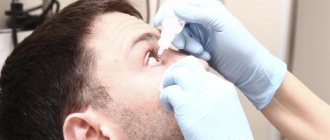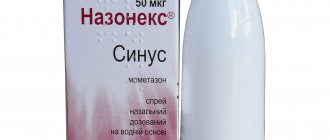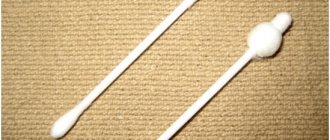Preparing to instill drops
Before you drop a medicinal substance into a child’s eyes, you need to prepare. To do this, the following devices are assembled at the workplace:
- towel;
- cotton pads and sticks;
- medicinal drops;
- a bag where used materials will be collected;
- if necessary, saline solution.
To avoid introducing a bacterial infection into your child’s eyes, you must thoroughly wash your hands with bactericidal soap before performing the procedure. There should be no soap particles left under the nails; if it gets into the child’s eyes, it will cause irritation.
It is also necessary to prepare the baby's eyes. Often with bacterial conjunctivitis, there may be purulent discharge in the eyes. In this case, the eyes are first treated with cotton pads that have been moistened with saline solution or Furacilin. It should be wiped very gently or blotted, because a child's skin is delicate. Excessive pressure can cause wounds and scratches.
Step-by-step instruction
1. Wash your hands thoroughly with soap, preferably antibacterial, and then wipe dry. You should not use a fluffy towel for these purposes, because it may leave lint on your palms, which can cause irritation if it gets into your eyes; in this case, it is better to prefer paper towels or napkins; 2. Before the procedure, be sure to wash or dry your eyes. If you have contact lenses, remove them if this is prescribed in the instructions for use (some modern drugs can be used with lenses); 3. Warm up the bottle with drops and your hands by rubbing them together. If you do this with cold hands, you cannot avoid contact, which can cause additional discomfort; 4. If the preparation uses a pipette to collect liquid, it must be strictly individual. When opening a new drug, a new pipette is used; 5. Prepare a small mirror to avoid harming yourself; 6. Take a comfortable position - sitting or lying on the bed, it is not recommended to perform the procedure while standing; 7. Tilt your head back; 8. Pull your lower eyelid with your finger to create a “pocket” that makes it easier for liquid to get into. Don't try too hard to do this as it may be painful; 9. Take the bottle, turn it over and bring the tip closer to the eye, but without touching the eye, mucous membrane or eyelashes; 10. During instillation, it is recommended to look up, but the tip should not go out of sight; 11. Place one or two drops of the medicine into the conjunctival sac, trying to get as close to the outer corner of the eye as possible - there is no need to use a large dosage, since this fold is not able to accommodate such an amount. If you drop more product than needed, it’s okay, the excess drops will be removed along with your tears; 12. Afterwards, do not rush to take a vertical position. Close your eyes for two to three minutes to distribute the drug evenly. It is not recommended to blink so as not to wash away the drops, but you can massage the corners of your eyes with light movements; 13. Dry your eye with a clean napkin; 14. Do the entire procedure with the second eye.
Important!
If you are prescribed several eye drops at once, maintain the required interval between them (from 10 to 30 minutes, the exact time depends on the specific drug). This way the components will not react with each other.
If everything is done correctly, you will get:
- The surgical result is that the eyeball is surrounded by multiple capillaries. When liquid gets on them, the product penetrates directly into the blood;
- Efficiency - liquid formulations contain those components that will allow you to quickly get the effect of their use: normalize blood pressure, cleanse the mucous membrane, eliminate the development of pathogenic microflora, wash away pathogens;
- Mild impact - some types of drops are designed to provide moisturizing and cleansing of the mucous membrane from pathogenic flora, as well as drying out while working at a computer monitor.
Precautionary measures
Medicines that are instilled into a child's eyes should only be prescribed by a doctor. Self-administration of the drug for a child is not recommended; the risk of side effects is high. The bottle of medicine must be unscrewed with clean hands, because bacteria on the skin can get inside.
While instilling the drug, do not touch the tip of the bottle to any surface. A large number of microorganisms are concentrated there, which will get into the medicinal liquid, after which it will be ineffective or dangerous for humans.
The child must be calm during the procedure. It is not recommended to instill the drug in a baby if he cries a lot. Tears will wash away most of the drug and there will be no effect.
Technique for putting drops into the eyes and toileting
Purpose: therapeutic, diagnostic Indications: inflammatory eye diseases, fundus examination Equipment: medications, 2 containers “clean pipettes”, “dirty pipettes”, furatsilin solution, tray for used material. Preparation for the procedure 1. Take the medicine, read its name and check the expiration date. 2. explain the procedure to the patient or mother 3. sit or lay the patient down 4. wash your hands 5. Note: if there is discharge from the eyes, first perform a toilet: take 2 sterile balls, soak in 0.02 furatsilin solution, squeeze out the excess furatsilina into the tray for used material, wash the child's eyes with a wet ball from the outer corner to the inner corner, put the used balls in the used material tray. Performing the procedure 1. Pipette the required number of drops 2. Ask the patient to slightly tilt his head back and look up 3. Press the cotton ball with 2 fingers of your left hand to the skin and pull the lower eyelid down 4. Place 2-3 drops of medicine into the lower conjunctival fold closer to inner corner of the eye 5. Ask the patient to close his eyes 6. Blot away any remaining drops. End of the procedure Make sure the patient does not experience discomfort after the procedure Infection control 1. Immerse the pipette in 3% chloramine solution for 60 minutes; tray in 3% chloramine solution for 60 minutes 2. cotton balls in 3% chloramine solution for 60 minutes. 3. Treat your hands on a social level.
You might be interested in:
- Nursing process in pediatrics
- Gastric lavage technique in children of different ages
- Technique for inserting a gas tube into an infant
- Technique for administering anti-tuberculosis vaccination and revaccination to a child
- Technique for performing the Mantoux reaction, evaluating the results
We recommend reading:
- Technique for taking swabs from the throat and nose for flora in children
- Technique for administering monovalent mumps vaccine
- DTP vaccination technique
- Technique for vaccination against polio
- Urine collection in infants
Algorithm for instilling drops
Instillation of the drug must be carried out in strict sequence. If one of the points is violated, side effects may occur, damage to the eyeball or surrounding skin surfaces. For each age, the algorithm for performing the procedure is different. This is due to the fact that every year the child develops more and more.
For any age, the following algorithm of actions must be performed:
- thorough hand washing using bactericidal soap and then rinsing it off with running warm water; hands should not be cold;
- It is not recommended to dry your hands with a towel, as lint may get on the skin, which will subsequently spread to the mucous membrane of the eyes;
- opening a pre-prepared bottle of medicine;
- instillation of the drug without touching the tip of the bottle to any tissues of the patient;
- It is better if the drops fall on the inner corner of the eyes in the area of the conjunctival sac;
- it is necessary to keep the child’s eyes open, you can help with your fingers, holding the lower eyelid, so the medicine will spread throughout the entire mucous membrane;
- after instillation is completed, the remaining medicinal substance is blotted with cotton pads or a napkin;
- The drops are covered with a lid and carefully screwed on so that there is no possibility of air or other substances getting inside.
The steps for instilling the drug are similar for children of different ages, but there are some differences
We give drops to the baby
If the child is an infant, he must be placed on his back, even if he can already sit. The eyes may be closed. You can drop the drug on the inner corner of the eyes, then slightly spread the eyelids with two fingers. The drug will still get inside and be distributed throughout the mucous membrane and conjunctival sac.
It should be remembered that the skin around the eyes of infants is much thinner. Therefore, any wiping should not be done. The eyes only get slightly wet.
We give drops to a child from one year old
If the child is older than 1 year, two body positions are possible in the space for instilling the drug. The child can sit with his head thrown back or lie down. If the baby is not afraid to put drops in his eyes and does the necessary actions on his own, it is better if they are open. If he is worried about this, you can also apply drops to your eyes closed, then slightly open your eyelids so that the drug spreads throughout the mucous membrane.
The skin of older children is not as delicate as that of a baby, but it is still necessary not to put pressure on the eyes, and not to rub too hard with cotton pads to wash away purulent discharge or excess drug.
Technique for instilling drops into the ear
Purpose: therapeutic Indications: inflammation of the middle ear, wax plug Contraindications: trauma to the middle ear Equipment: medications, 2 containers: “clean pipettes”, “dirty pipettes”, a glass of water 50-60°, a tray for used material Preparation for procedure 1 .Take the medicine, read the name and check the expiration date 2. Warm the medicine solutions to body temperature 3. Explain the procedure to the patient 4. Wash your hands 5. Lay the patient on his side, with the affected ear up Performing the procedure 6. Take the pipette in your right hand, draw medicine into the pipette, pull the auricle backwards and upwards with fingers 1 and 2 of the left hand, for small children backwards and downwards 7. Place 3-4 drops into the ear canal End of the procedure 8. Ask the patient to lie on this side for 10-15 minutes 9. place the pipette in the disinfectant solution 10. help the patient sit up 11. ask the patient how he is feeling
Recommendations
Doctors often prescribe eye drops that should be kept in the refrigerator. For example, antibiotics. It is not recommended to use cold liquid. Therefore, it should be warmed under running water using your hands. You can take a small amount of the product and leave it for a short period of time in a warm room.
If you need to use several products at once, it is recommended to consult your doctor first. They may be at high risk for drug interactions, which may increase or decrease the effects. If this is not possible, it is recommended to wait at least 30 minutes between instillations of drugs.
All parents of small children should keep droppers at home. They are necessary in case the bottle with drops is not equipped with a dropper.
Common mistakes when giving drops to a newborn
- If you need to put drops into the eyes of a newborn, it is important not to scare the baby. To do this, you should act gently, without pressure or raising your voice. You can swaddle him to reduce the range of movements for a few minutes, distract him with your favorite toy or pleasant sounds. If you act more roughly, the child may remember the procedure and start hysterics with any attempt at treatment.
- Many parents follow the lead of their grandmothers, trying to enhance treatment with folk remedies, decoctions or homemade infusions. The combination of natural ingredients and medications can have negative effects if they react. Therefore, any prescriptions are made by a doctor, selecting medications based on tests and diagnosis.
- Parents should monitor the condition of the cornea and eye whites. It is a mistake to try to continue treatment if there is severe redness and excessive release of tear fluid. In this case, it is necessary to seek repeated consultation with an ophthalmologist.
Today in the article, using an algorithm, we tried to figure out how to put drops into the eyes of a newborn. During treatment, it is important to maintain sterility and accuracy, and monitor for side effects of the drug. If precautions are not followed, a new infection can be introduced and harm the child. How did you cope with vagaries during the procedure?
Subscribe to updates on our website and share useful tips with other parents in the comments!
Be healthy!
Common Mistakes
To eliminate the risk of side effects after instillation of drugs, parents should know which actions are strictly prohibited:
- self-prescription of a drug;
- instilling medications into a child who is crying a lot or is in a state of hysterics;
- re-instillation of the drug, if most of it flowed out, in fact, the required proportion of the drug was distributed over the eyes and fulfilled its effect, only the excess flowed out;
- touching the tip of the bottle to the mucous membrane or eyelids;
- lack of hand washing before the procedure;
- failure to remove purulent discharge from the child’s eyes before instilling the drug, as this will prevent the substance from reaching all the necessary areas;
- rubbing the child's eyes forcefully with cotton pads, napkins or towels;
- simultaneous instillation of two drugs at once;
- the use of medicines that have expired; for most drops, after opening the bottle, the shelf life is reduced to 1 month; after this period, the drug must be thrown away, since pathogenic substances have accumulated inside the liquid;
- violation of instructions on the amount of instillation of the drug on the first day;
- an excessively long course of treatment that was not necessary, for example, when using antibiotics for more than 7 days, bacteria develop resistance to the active substance.
If all of the above rules have been followed, the disease will pass quickly and without complications. After completing the entire course of treatment, it is recommended to visit the ophthalmologist again to prevent relapse of the disease.
Technique for putting drops into the nose
Purpose: therapeutic Indications: inflammation of the nasal mucosa Contraindications: nosebleeds, nasal trauma with damage to the mucous membrane Equipment: container “clean pipettes”, “dirty pipettes”, gauze napkins or a handkerchief, thick cotton wool, a tray for used material. Preparation for the procedure 1. Put on a mask 2. Take the medicine, read its name and check the expiration date. 3.Prepare pipettes 4.Explain the procedure to the patient or mother 5.Wash your hands 6.Sit the patient down 7.Clean the nasal passages: to toilet the nose of small children - take 2 dry cotton wool with your right hand, fix the head with your left hand so that the first finger is on the forehead, and the palm and 2,3,4,5 fingers on the parietal and occipital areas of the child’s head; With your right hand, carefully insert the cotton wool into the nasal passage with rotational movements and move it inward by 1-1.5 cm. Older children blow their nose into a handkerchief. ATTENTION! Each nasal passage needs a separate flagellum. It is strictly forbidden to use thick objects to clean the nose. Performing the procedure 1. Turn the patient’s head in the direction in which you are injecting the medicine, fix the head with your left hand, lift the tip of the nose with the thumb of the same hand 2. Place 3-4 drops on the mucous membrane of the nasal wing 3. Attention! Do not insert the pipette deep into the nose, try not to touch the nose with the pipette 4. Press the wings of the nose against the septum and make light rotational movements 5. After 1-2 minutes, drop drops into the 2nd nostril, follow the same rules. End of the procedure. Give the child a comfortable position. Note: When instilling oil drops, place the child with his head slightly tilted back and instill 5-6 drops. The patient should feel the taste of the drops.










